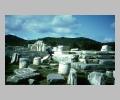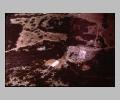| Summary: | A remote Attic deme center and secondary Attic port. |
| Type: | Fortified city and sanctuary |
| Region: | Attica |
Periods:
Archaic
Classical
Hellenistic
Physical:
Rhamnous was a remote Attic deme center on a small sheltered bay along the rocky NE Attic coast. It was strategically important because it overlooked a narrow stretch of the Euboean channel. After Athens lost Dekelia in 412 B.C., it also became important as the main harbor for import of food supplies from Euboea. The hamlet at Rhamnous had a small temple, a gymnasium and a small theater which may have served for civic assemblies as well as performances. Within the town's fortifications a hill top was enclosed in a 2nd circuit of walls and may have held a permanent Athenian garrison.
A route led from the town, through the necropolis and up to the Sanctuary of Nemesis and Themis situated on an artificial terrace facing the sea. The temenos was entered from the SE and contained 2 small, closely adjacent temples and a number of sculptures and dedications.
Description:
The deme center at Rhamnous was fortified in the 5th or 4th century B.C. and probably received a permanent garrison because of its strategic position. The cult of Nemesis and Themis was well known at Rhamnous as early as the 6th century B.C. and the smaller and earlier temple (ca. 480 B.C.) may have been dedicated to both of the gods. The later temple (ca. 420 B.C.) was dedicated to Nemesis alone, but was left unfinished.
Exploration:
Society of Dilettanti made plans of the temples of Nemesis and Themis in 1817. Minor excavation on the acropolis by D. Philios in 1880. 1890-1893 M. Stais continued on the acropolis and in the sanctuary. In 1922-23 and in 1947 studies and surveys carried out by: A. Orlandos, Zschietzschmann, Plommer, Dinsmoor, J. Pouilloux and J. Marcadé. Excavations by Mastrokostas in 1958 and in 1960 by I. Kondis and V. Petrakos.
Sources Used:
Other Bibliography:





